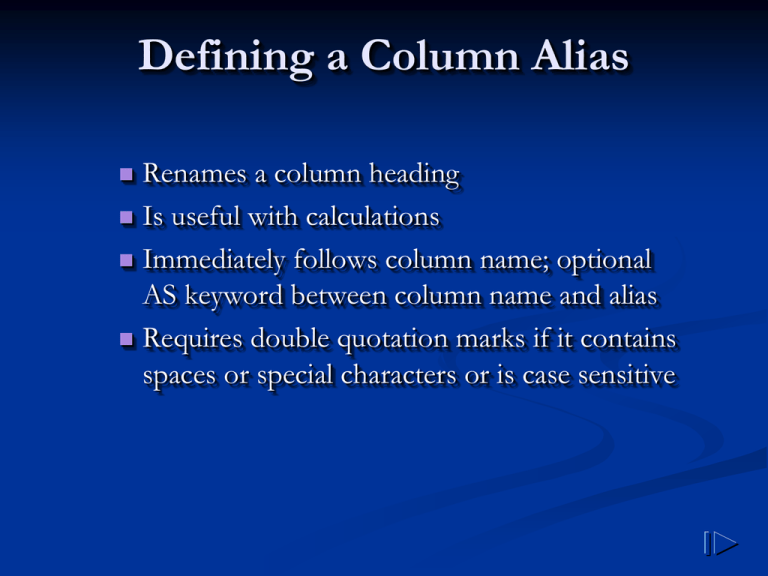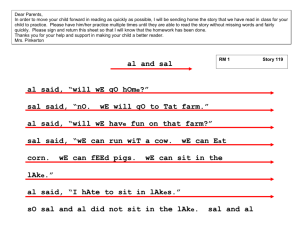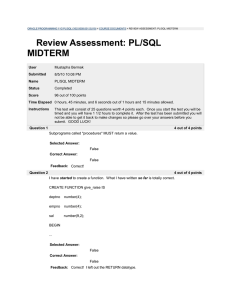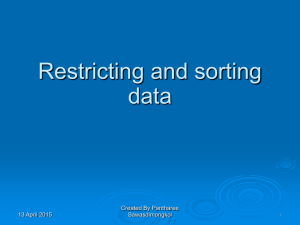sql
advertisement

Defining a Column Alias
Renames a column heading
Is useful with calculations
Immediately follows column name; optional
AS keyword between column name and alias
Requires double quotation marks if it contains
spaces or special characters or is case sensitive
Using Column Aliases
SQL> SELECT ename AS name, sal salary
2 FROM
emp;
NAME
SALARY
------------- --------...
SQL> SELECT ename "Name",
2
sal*12 "Annual Salary"
3 FROM
emp;
Name
Annual Salary
------------- ------------...
Concatenation Operator
Concatenates columns or character strings to
other columns
Is represented by two vertical bars (||)
Creates a resultant column that is a character
expression
Using the Concatenation
Operator
SQL> SELECT
2 FROM
ename||job AS "Employees"
emp;
Employees
------------------KINGPRESIDENT
BLAKEMANAGER
CLARKMANAGER
JONESMANAGER
MARTINSALESMAN
ALLENSALESMAN
...
14 rows selected.
Literal Character Strings
A literal is a character, a number, or a date
included in the SELECT list.
Date and character literal values must be
enclosed within single quotation marks.
Each character string is output once for each
row returned.
Using Literal Character Strings
SQL> SELECT ename ||' is a '||job
2
AS "Employee Details"
3 FROM
emp;
Employee Details
------------------------KING is a PRESIDENT
BLAKE is a MANAGER
CLARK is a MANAGER
JONES is a MANAGER
MARTIN is a SALESMAN
...
14 rows selected.
Duplicate Rows
The default display of queries is all rows,
including duplicate rows.
SQL> SELECT deptno
2 FROM
emp;
DEPTNO
--------10
30
10
20
...
14 rows selected.
Eliminating Duplicate Rows
Eliminate duplicate rows by using the
DISTINCT keyword in the SELECT clause.
SQL> SELECT DISTINCT deptno
2 FROM
emp;
DEPTNO
--------10
20
30
Comparison Operators
Operator
Meaning
=
Equal to
>
Greater than
>=
Greater than or equal to
<
Less than
<=
Less than or equal to
<>, !=, ^=
Not equal to
Using the Comparison Operators
SQL> SELECT ename, sal, comm
2 FROM
emp
3 WHERE sal<=comm;
ENAME
SAL
COMM
---------- --------- --------MARTIN
1250
1400
Other Comparison Operators
Operator
Meaning
BETWEEN
...AND...
Between two values (inclusive)
IN(list)
Match any of a list of values
LIKE
Match a character pattern
IS NULL
Is a null value
Using the BETWEEN Operator
Use the BETWEEN operator to display
rows based on a range of values.
SQL> SELECT
2 FROM
3 WHERE
ename, sal
emp
sal BETWEEN 1000 AND 1500;
ENAME
SAL
---------- --------MARTIN
1250
TURNER
1500
WARD
1250
ADAMS
1100
MILLER
1300
Lower
limit
Higher
limit
Using the IN Operator
Use the IN operator to test for values in a
list.
SQL> SELECT
2 FROM
3 WHERE
EMPNO
--------7902
7369
7788
7876
empno, ename, sal, mgr
emp
mgr IN (7902, 7566, 7788);
ENAME
SAL
MGR
---------- --------- --------FORD
3000
7566
SMITH
800
7902
SCOTT
3000
7566
ADAMS
1100
7788
Using the LIKE Operator
• Use the LIKE operator to perform
wildcard searches of valid search string
values.
• Search conditions can contain either
literal characters or numbers.
– % denotes zero or many characters.
– _ denotes one character.
SQL> SELECT
2 FROM
3 WHERE
ename
emp
ename LIKE 'S%';
Using the LIKE Operator
You can combine pattern-matching characters.
SQL> SELECT
2 FROM
3 WHERE
ENAME
---------MARTIN
JAMES
You can
WARD
ename
emp
ename LIKE '_A%';
use the ESCAPE identifier to search
for "%" or "_".
Using the IS NULL Operator
Test for null values with the IS NULL
operator.
SQL> SELECT
2 FROM
3 WHERE
ename, mgr
emp
mgr IS NULL;
ENAME
MGR
---------- --------KING
Logical Operators
Operator
Meaning
AND
Returns TRUE if both component
conditions are TRUE
OR
Returns TRUE if either component
condition is TRUE
NOT
Returns TRUE if the following
condition is FALSE
Using the AND Operator
AND requires both conditions to be TRUE.
SQL>
2
3
4
SELECT
FROM
WHERE
AND
EMPNO
--------7876
7934
empno, ename, job, sal
emp
sal>=1100
job='CLERK';
ENAME
---------ADAMS
MILLER
JOB
SAL
--------- --------CLERK
1100
CLERK
1300
Using the OR Operator
OR requires either condition to be TRUE.
SQL>
2
3
4
SELECT
FROM
WHERE
OR
empno, ename, job, sal
emp
sal>=1100
job='CLERK';
EMPNO ENAME
--------- ---------7839 KING
7698 BLAKE
7782 CLARK
7566 JONES
7654 MARTIN
...
7900 JAMES
...
14 rows selected.
JOB
SAL
--------- --------PRESIDENT
5000
MANAGER
2850
MANAGER
2450
MANAGER
2975
SALESMAN
1250
CLERK
950
Using the NOT Operator
SQL> SELECT ename, job
2 FROM
emp
3 WHERE job NOT IN ('CLERK','MANAGER','ANALYST');
ENAME
---------KING
MARTIN
ALLEN
TURNER
WARD
JOB
--------PRESIDENT
SALESMAN
SALESMAN
SALESMAN
SALESMAN
Rules of Precedence
Order Evaluated
1
2
3
4
Operator
All comparison
operators
NOT
AND
OR
Override rules of precedence by using
parentheses.
Rules of Precedence
SQL>
2
3
4
5
SELECT
FROM
WHERE
OR
AND
ENAME
---------KING
MARTIN
ALLEN
TURNER
WARD
ename, job, sal
emp
job='SALESMAN'
job='PRESIDENT'
sal>1500;
JOB
SAL
--------- --------PRESIDENT
5000
SALESMAN
1250
SALESMAN
1600
SALESMAN
1500
SALESMAN
1250
Rules of Precedence
Use parentheses to force priority.
SQL>
2
3
4
5
SELECT
FROM
WHERE
OR
AND
ENAME
---------KING
ALLEN
ename, job, sal
emp
(job='SALESMAN'
job='PRESIDENT')
sal>1500;
JOB
SAL
--------- --------PRESIDENT
5000
SALESMAN
1600
Sorting by Column Alias
SQL> SELECT
empno, ename, sal*12 annsal
2 FROM
emp
3 ORDER BY annsal;
EMPNO ENAME
ANNSAL
--------- ---------- --------7369 SMITH
9600
7900 JAMES
11400
7876 ADAMS
13200
7654 MARTIN
15000
7521 WARD
15000
7934 MILLER
15600
7844 TURNER
18000
...
14 rows selected.
Sorting by Multiple Columns
The order of ORDER BY list is the order of sort.
SQL> SELECT
ename, deptno, sal
2 FROM
emp
3 ORDER BY deptno, sal DESC;
ENAME
DEPTNO
SAL
---------- --------- --------KING
10
5000
CLARK
10
2450
MILLER
10
1300
FORD
20
3000
...
14 rows selected.
• You can sort by a column that is not in the
SELECT list.
Single-Row Functions
Character Functions
CONCAT – joins 2 character strings
INITCAP – returns a string with the initial letter only uppercase
LENGTH – returns the length of a string
LPAD, RPAD – returns a string with a specific number of
characters added on the left or right side
LTRIM, RTRIM – returns a string with all instances of a specific
character trimmed from the left or right side
REPLACE – replaces all instances of a character with another
character
UPPER/LOWER – returns a string in all upper/lower case
letters
SUBSTR
INSTR
Case Conversion Functions
Convert case for character strings
Function
Result
LOWER('SQL Course')
sql course
UPPER('SQL Course')
SQL COURSE
INITCAP('SQL Course') Sql Course
Using Case Conversion
Functions
Display the employee
number, name, and
department number for employee Blake.
SQL> SELECT empno, ename, deptno
2 FROM
emp
3 WHERE
ename = 'blake';
no rows selected
SQL> SELECT
2 FROM
3 WHERE
empno, ename, deptno
emp
ename = UPPER('blake');
EMPNO ENAME
DEPTNO
--------- ---------- --------7698 BLAKE
30
Character Manipulation
Functions
Manipulate character strings
Function
CONCAT('Good', 'String')
Result
GoodString
SUBSTR('String',1,3)
Str
LENGTH('String')
6
INSTR('String', 'r')
3
LPAD(sal,10,'*')
******5000
TRIM('S' FROM 'SSMITH')
MITH
Using the Character
Manipulation Functions
SQL> SELECT ename, CONCAT (ename, job), LENGTH(ename),
2
INSTR(ename, 'A')
3 FROM
emp
4 WHERE SUBSTR(job,1,5) = 'SALES';
ENAME
---------MARTIN
ALLEN
TURNER
WARD
CONCAT(ENAME,JOB)
LENGTH(ENAME) INSTR(ENAME,'A')
------------------- ------------- ---------------MARTINSALESMAN
6
2
ALLENSALESMAN
5
1
TURNERSALESMAN
6
0
WARDSALESMAN
4
2
Number Functions
ABS - absolute value
CEIL – rounds a number up to the next integer
FLOOR – rounds a number down to the previous
integer
MOD – returns the remainder of a number and a
divisor
POWER - raises a number to an exponent
ROUND - rounds a number
SQRT – returns the square root of a value
TRUNC - truncates a number to the nearest whole
number
Number Functions
ROUND: Rounds value to specified
decimal
ROUND(45.926, 2)
45.93
TRUNC:
Truncates value to specified
decimal
TRUNC(45.926, 2)
45.92
MOD: Returns remainder of division
MOD(1600, 300)
100
Using the ROUND Function
SQL> SELECT ROUND(45.923,2), ROUND(45.923,0),
2
ROUND(45.923,-1)
3 FROM
DUAL;
ROUND(45.923,2) ROUND(45.923,0) ROUND(45.923,-1)
--------------- -------------- ----------------45.92
46
50
Using the TRUNC Function
SQL> SELECT TRUNC(45.923,2), TRUNC(45.923),
2
TRUNC(45.923,-1)
3 FROM
DUAL;
TRUNC(45.923,2) TRUNC(45.923) TRUNC(45.923,-1)
--------------- ------------- --------------45.92
45
40
Using the MOD Function
Calculate the remainder of the ratio of
salary to commission for all employees
whose job title is salesman.
SQL> SELECT
2 FROM
3 WHERE
ename, sal, comm, MOD(sal, comm)
emp
job = 'SALESMAN';
ENAME
SAL
COMM MOD(SAL,COMM)
---------- --------- --------- ------------MARTIN
1250
1400
1250
ALLEN
1600
300
100
TURNER
1500
0
1500
WARD
1250
500
250
What Are Group Functions?
Group functions operate on sets of rows to give
one result per group.
EMP
DEPTNO
SAL
--------- --------10
2450
10
5000
10
1300
20
800
20
1100
20
3000
20
3000
20
2975
30
1600
30
2850
30
1250
30
950
30
1500
30
1250
“maximum
salary in
the EMP table”
MAX(SAL)
--------5000
Types of Group Functions
AVG
COUNT
COUNT(*)
MAX
MIN
SUM
Using Group Functions
SELECT
FROM
[WHERE
[GROUP BY
[ORDER BY
[column,] group_function(column)
table
condition]
column]
column];
Using AVG and SUM Functions
You can use AVG and SUM for numeric data.
SQL> SELECT
2
3 FROM
4 WHERE
AVG(sal), MAX(sal),
MIN(sal), SUM(sal)
emp
job LIKE 'SALES%';
AVG(SAL) MAX(SAL) MIN(SAL) SUM(SAL)
-------- --------- --------- --------1400
1600
1250
5600
Using MIN and MAX Functions
You can use MIN and MAX for any datatype.
SQL> SELECT
2 FROM
MIN(hiredate), MAX(hiredate)
emp;
MIN(HIRED MAX(HIRED
--------- --------17-DEC-80 12-JAN-83
Using the COUNT Function
COUNT(*) returns the number of rows in a
table.
SQL> SELECT
2 FROM
3 WHERE
COUNT(*)
--------6
COUNT(*)
emp
deptno = 30;
Using the COUNT Function
COUNT(expr) returns the number of
nonnull rows.
SQL> SELECT
2 FROM
3 WHERE
COUNT(COMM)
----------4
COUNT(comm)
emp
deptno = 30;
Creating Groups of Data
EMP
DEPTNO
SAL
--------- --------10
2450
10
5000
10
1300
20
800
20
1100
20
3000
20
3000
20
2975
30
1600
30
2850
30
1250
30
950
30
1500
30
1250
2916.6667
“average
DEPTNO AVG(SAL)
salary
------- --------in
EMP
2175
10 2916.6667
table
20
2175
for each
department”
30 1566.6667
1566.6667
Creating Groups of Data:
GROUP BY Clause
SELECT
FROM
[WHERE
[GROUP BY
[ORDER BY
column, group_function(column)
table
condition]
group_by_expression]
column];
Divide rows in a table into smaller groups
by using the GROUP BY clause.
Using the GROUP BY Clause
All columns in the SELECT list that are not
in group functions must be in the GROUP
BY clause.
SQL> SELECT
deptno, AVG(sal)
2 FROM
emp
3 GROUP BY deptno;
DEPTNO AVG(SAL)
--------- --------10 2916.6667
20
2175
30 1566.6667
Using the GROUP BY Clause
The GROUP BY column does not have to
be in the SELECT list.
SQL> SELECT
AVG(sal)
2 FROM
emp
3 GROUP BY deptno;
AVG(SAL)
--------2916.6667
2175
1566.6667
EMP
DEPTNO
--------10
10
10
20
20
20
20
20
30
30
30
30
30
30
Grouping by More
Than One Column
JOB
SAL
--------- --------MANAGER
2450
PRESIDENT
5000
CLERK
1300
CLERK
800
CLERK
1100
ANALYST
3000
ANALYST
3000
MANAGER
2975
SALESMAN
1600
MANAGER
2850
SALESMAN
1250
CLERK
950
SALESMAN
1500
SALESMAN
1250
“sum salaries in
the EMP table
for each job,
grouped by
department”
DEPTNO
-------10
10
10
20
20
20
30
30
30
JOB
SUM(SAL)
--------- --------CLERK
1300
MANAGER
2450
PRESIDENT
5000
ANALYST
6000
CLERK
1900
MANAGER
2975
CLERK
950
MANAGER
2850
SALESMAN
5600
Using the GROUP BY Clause
on Multiple Columns
SQL> SELECT
deptno, job, sum(sal)
2 FROM
emp
3 GROUP BY deptno, job;
DEPTNO JOB
SUM(SAL)
--------- --------- --------10 CLERK
1300
10 MANAGER
2450
10 PRESIDENT
5000
20 ANALYST
6000
20 CLERK
1900
...
9 rows selected.
Excluding Group Results:
HAVING Clause
Use the HAVING clause to restrict groups
Rows are grouped.
The group function is applied.
Groups matching the HAVING clause are
displayed.
SELECT
FROM
[WHERE
[GROUP BY
[HAVING
[ORDER BY
column, group_function
table
condition]
group_by_expression]
group_condition]
column];
Using the HAVING Clause
SQL>
2
3
4
SELECT
FROM
GROUP BY
HAVING
deptno, max(sal)
emp
deptno
max(sal)>2900;
DEPTNO MAX(SAL)
--------- --------10
5000
20
3000
Using the HAVING Clause
SQL>
2
3
4
5
6
SELECT
FROM
WHERE
GROUP BY
HAVING
ORDER BY
job, SUM(sal) PAYROLL
emp
job NOT LIKE 'SALES%'
job
SUM(sal)>5000
SUM(sal);
JOB
PAYROLL
--------- --------ANALYST
6000
MANAGER
8275
Nesting Group Functions
Display the maximum average salary.
SQL> SELECT
max(avg(sal))
2 FROM
emp
3 GROUP BY deptno;
MAX(AVG(SAL))
------------2916.6667


